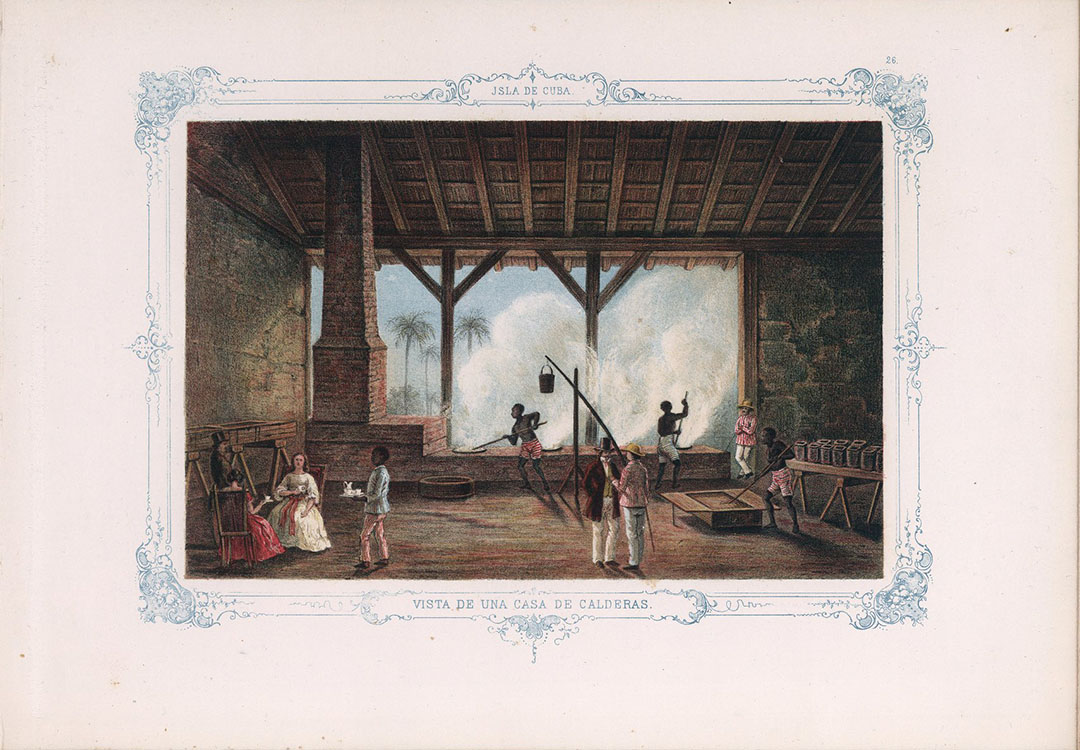PALIMPSESTS
Labor

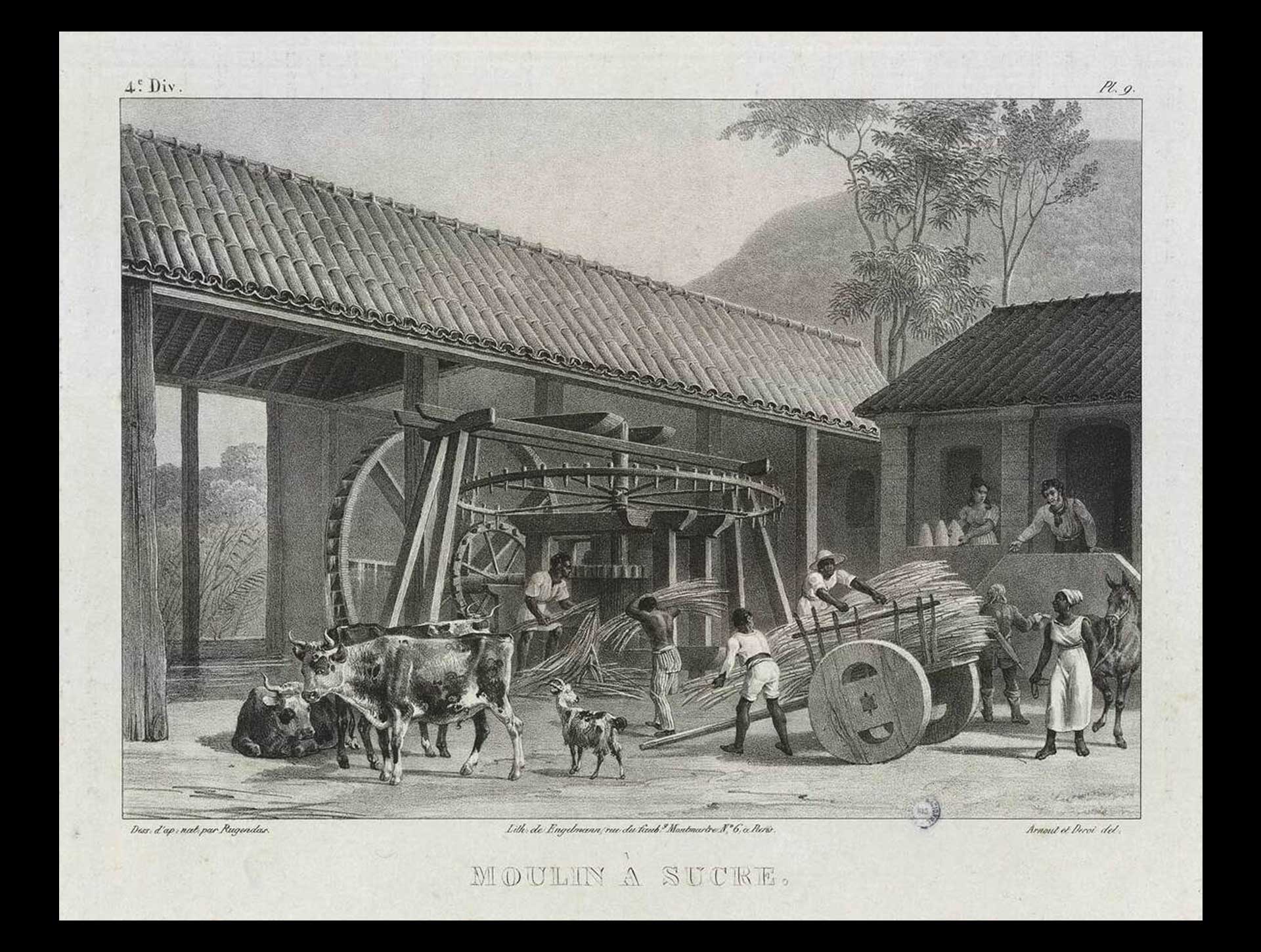
Nineteenth-century images of plantations across the Americas usually feature slave labor to convey a sense of harmony and efficiency. Published in travel accounts and picturesque albums or commissioned by planters themselves, these images depict enslaved men and women performing manual tasks, although the extenuating aspect of their labor is often obscured. They cut and grind cane, pick and press cotton, harvest coffee, or process sugar, while light-skinned overseers and white planters seem to be standing still, at times in resting positions. In the 1835 lithograph Moulin à sucre [Sugar Mill] by Johann Moritz Rugendas, for instance, every enslaved person appears to be tending to the grinding mill on a Brazilian plantation.
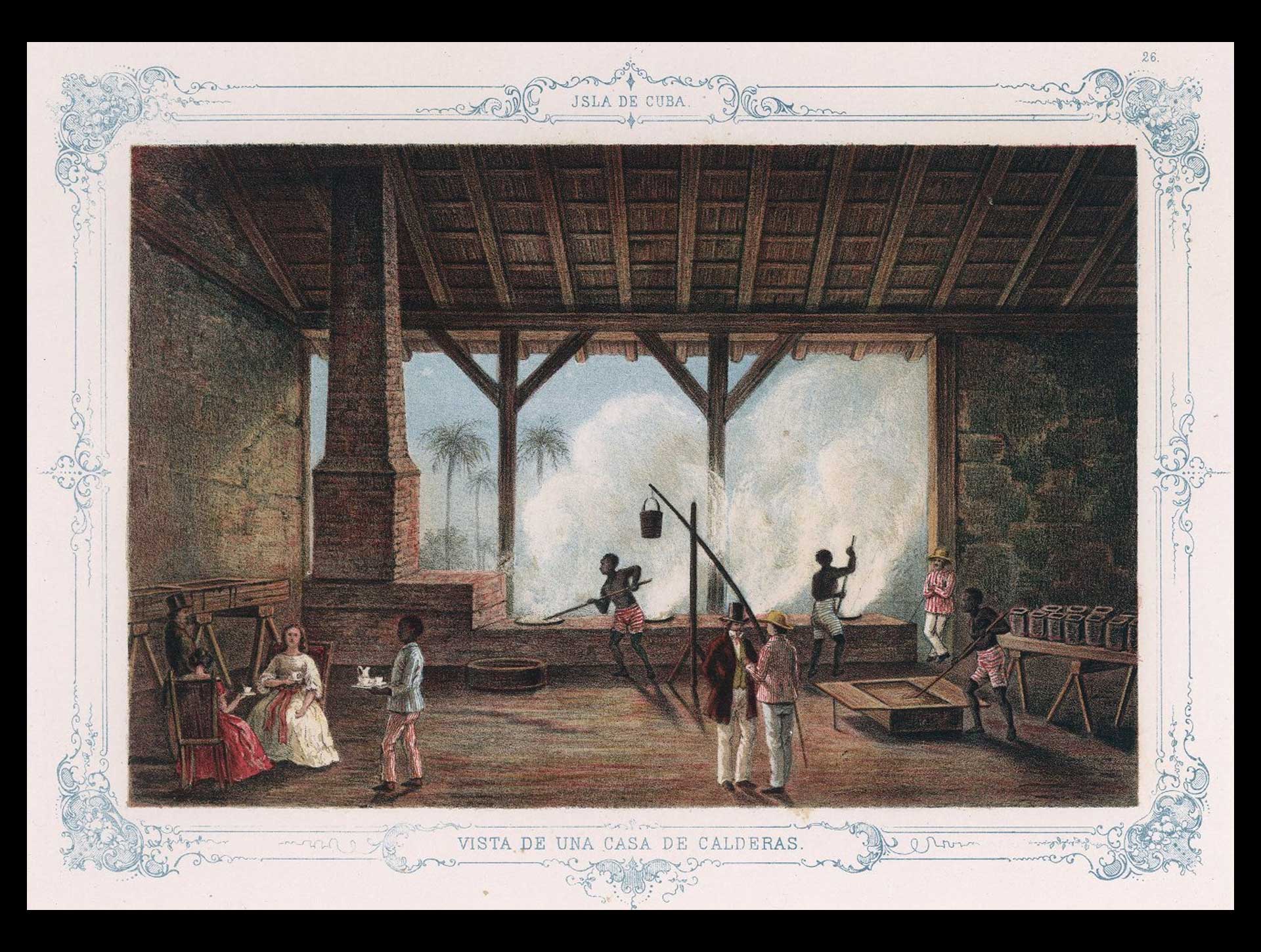
Such racialization of labor is also visualized in Frédéric Mialhe’s Vista de una casa de calderas [View of a Sugar Boiling House], published in the 1855 Album pintoresco de la isla de Cuba. In this seemingly peaceful scene, the four enslaved men are the only ones engaged in physical labor: two of them tend to the boiling sugarcane juice in the caldrons, while a third one stirs the reduced juice in a resfriadera until it crystallizes. On the left, an enslaved young man—the only one wearing a shirt—serves beverages in a porcelain set to two white women. Mialhe condenses the logic of the plantation in one single space where white idleness is only possible through Black labor.

The overseers, depicted in white-and-red-striped shirts, are not engaged in physical labor: one of them is leaning against a wooden pillar while the other talks to a gentleman, presumably the plantation owner. While conventional picturesque depictions of Cuba tend to emphasize the exuberance of tropical nature, here the steam coming out of the open caldrons—a result of enslaved labor—clouds the view of the palm trees adorning the plantation.
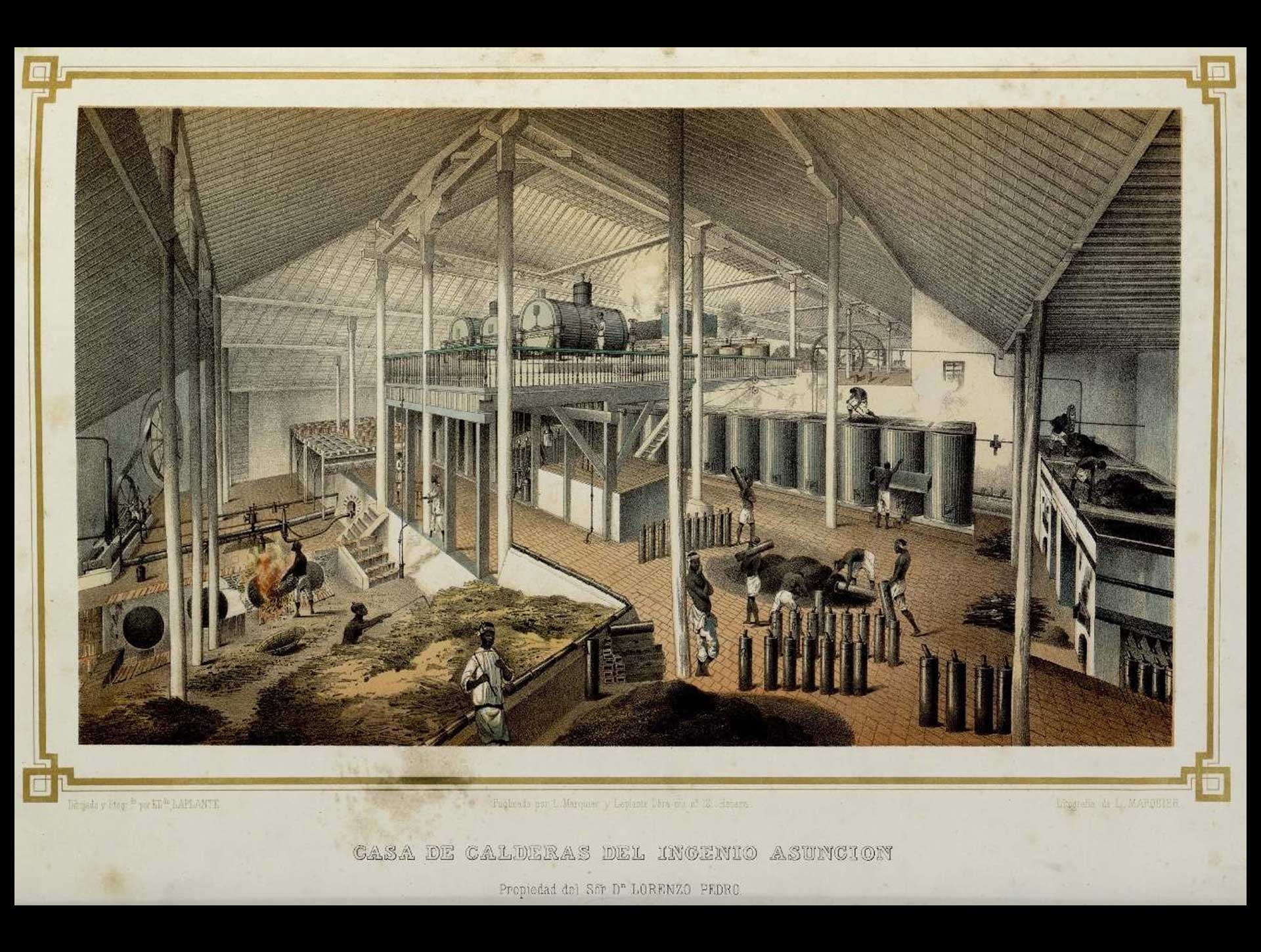
A sense of order and efficiency is also at the center of Casa de calderas del Ingenio Asunción [Boiling House of the Asunción Plantation], by Eduardo Laplante. Like Mialhe, Laplante was a French lithographer who documented his travels around Cuba with picturesque images of slaveholding plantations while earning a living as a sales representative for sugar machinery manufacturers. This lithograph was published in the book Los ingenios: colección de vistas de los principales ingenios de azúcar de la isla de Cuba (1856-7) to accompany the text by Justo Cantero, a wealthy planter at the time.
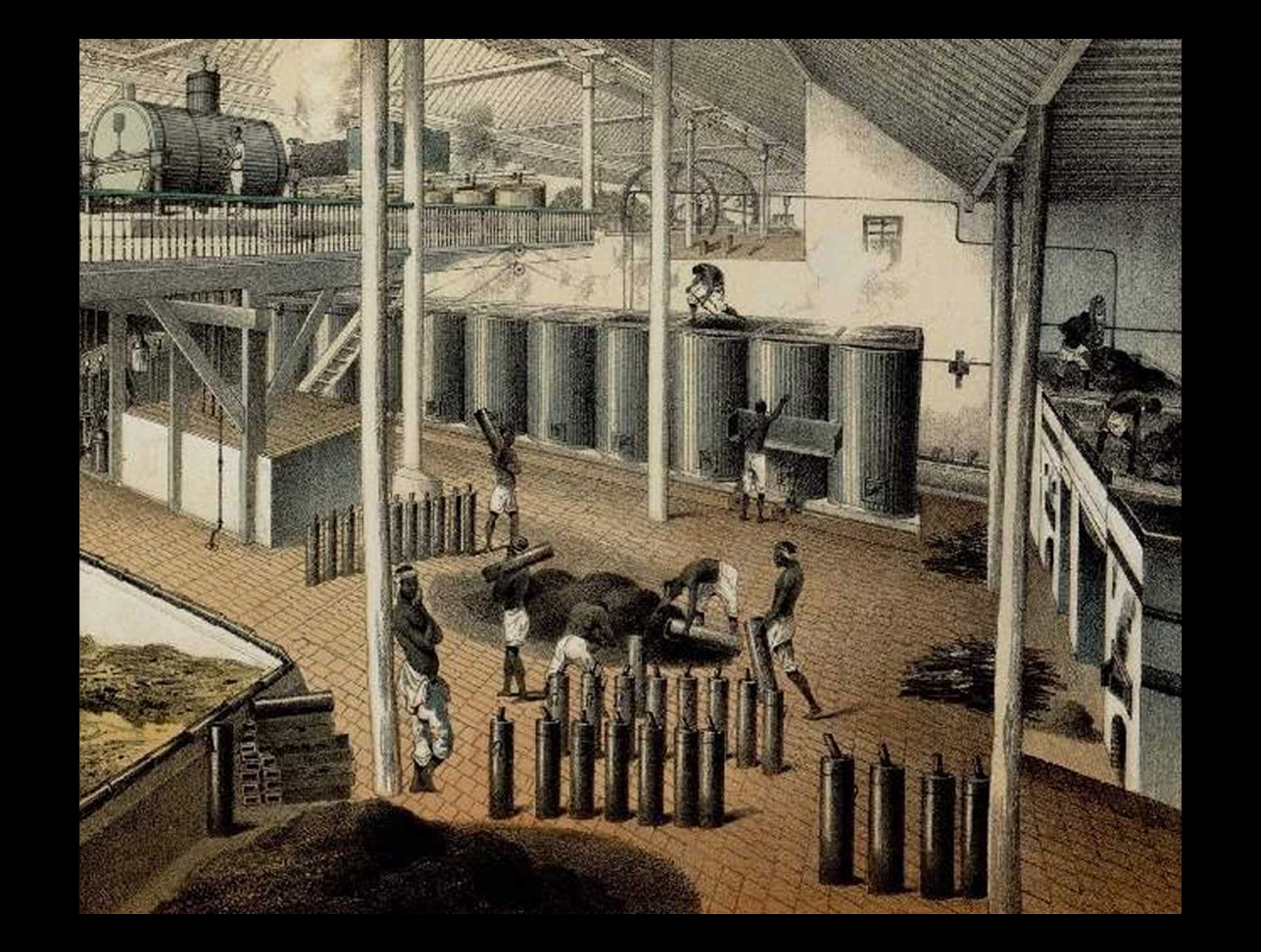
Commissioned to showcase the alleged wealth and modernization of Cuban ingenios, the book focuses not so much on the labor of the enslaved but on technology. The description of Asunción’s boiling house emphasizes the then modern Rillieux system with horizontal evaporators (on the second floor), which contained the steam from the boiling sugar cane, making its production more efficient. The slaveholding ingenio is actually visualized here as a modernized space, reminiscent of a European factory. The enslaved workers, most of them shirtless, are all engaged in the process which, though semi-industrialized, still demanded strenuous physical labor. All except one.

At the center of the lithograph, a man stands out as the only one who seems not to be working or holding a tool. He is leaning against a wooden column with his arms and legs crossed, indicating a resting position. As is the case with most of the enslaved subjects depicted in Los ingenios, his facial features are not fully discernable. Yet, he seems to cast an ambiguous gaze—is he looking back at the viewer or out of the frame?
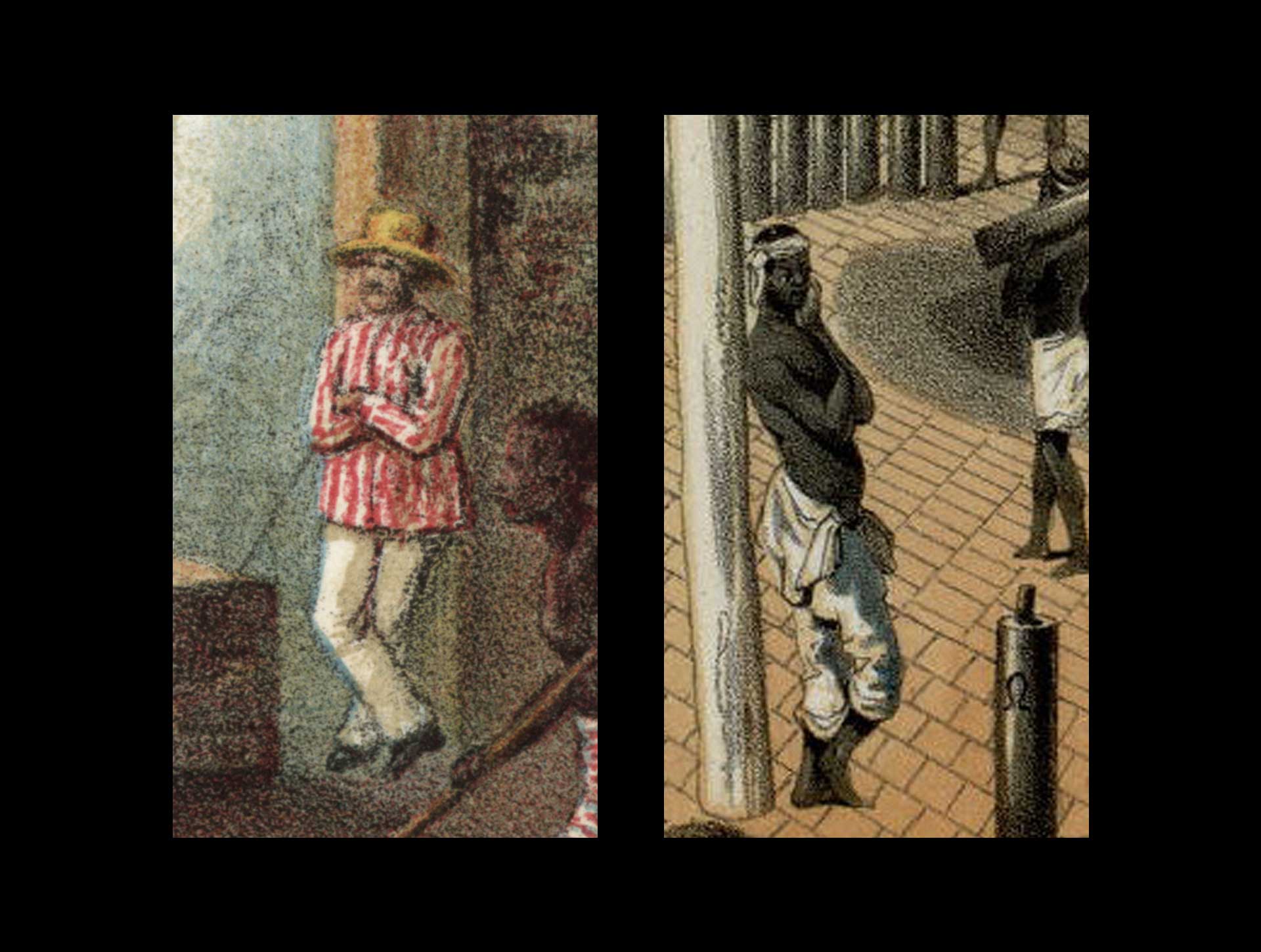
Significantly, this enslaved worker’s position is almost identical to that of the white overseer depicted in Mialhe’s lithograph. While the overseer is still fulfilling his duties—i.e., watching over the labor of the enslaved—the enslaved figure is clearly not working. Why would Laplante choose to depict an idle figure in this supposedly modern and efficient space? On the one hand, it could be a way of showcasing the Asunción plantation as an example of the so-called “buen tratamiento” or good treatment, an ameliorative policy envisioned by Cuban planters with the goal of extending the lives of the enslaved population in the face of trade restrictions and increases in prices. Under this logic, depicting an enslaved man at rest would convey the image that the Asunción plantation did not overwork its enslaved workforce.
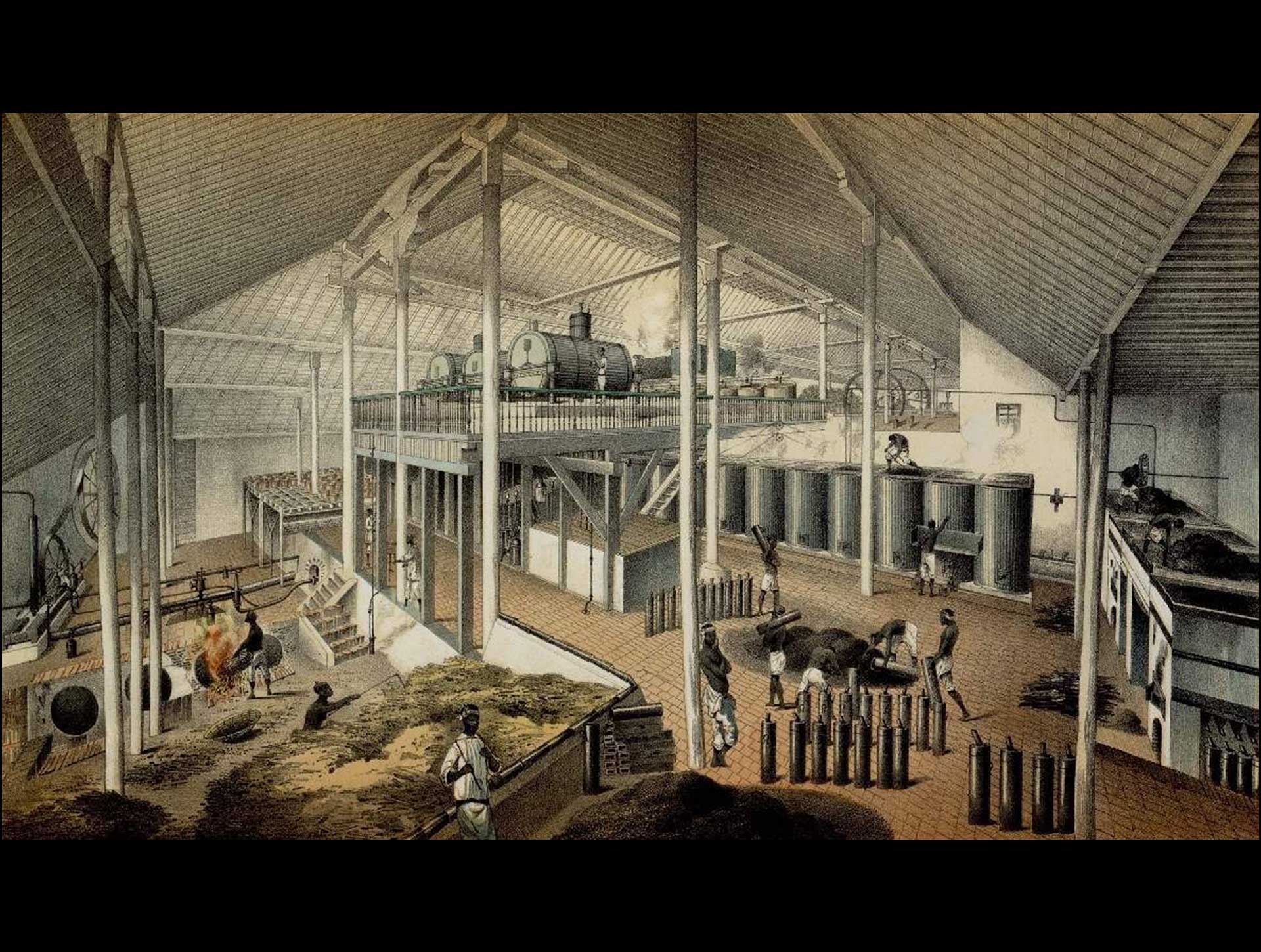
Yet, large nineteenth-century Cuban plantations such as Asunción did not grant breaks to enslaved workers in a labor-intensive environment such as that of a boiling house. Nor is there the possibility of discipline here, as there is no overseer in sight: on the second floor of the boiling house, we see the sugar master, the only non-enslaved person in the image. In such a scenario, the enslaved man’s idleness poses a challenge to the plantation order, under which the bodies of the enslaved have come to index labor and subservience.

In spaces that came to signify Black labor, images of Afrodescendant workers at rest still hold the potential to challenge the visual order of racial capitalism in the Americas. In this well-known photograph taken by Sebastião Salgado in the late 1980s, a young gold miner is standing still amidst the labor of others in the Serra Pelada mine, the world’s largest open mine at the time. Salgado’s emblematic photographs documented the exploitation of more than 100,000 miners who, he lamented, “become slaves of the dream of gold and the need to stay alive.” Strikingly—yet unintentionally perhaps—Salgado’s metaphor reinforces the association between labor and Blackness. Still, this photograph briefly subverts this association by depicting, once again, an Afrodescendant worker in a moment of idleness.

In contrast to all the men around him, the young Afro-Brazilian miner in Salgado’s photograph is not engaged in labor. Like the enslaved man in Laplante’s lithograph, he is leaning against a wooden pillar. The black-and-white photograph emphasizes the chaos of the environment, where mud and men, wood and fabric, seem to merge. Unlike Laplante’s image, however, there is no ambiguity in the miner’s gaze. With his arms crossed and his head turned to the side, he seems to refuse to look at the camera. Such refusal adds another layer of challenge to the visual order of Serra Pelada captured by Salgado: not only is the young miner not mining, he is also not performing or posing for the photographer’s camera.
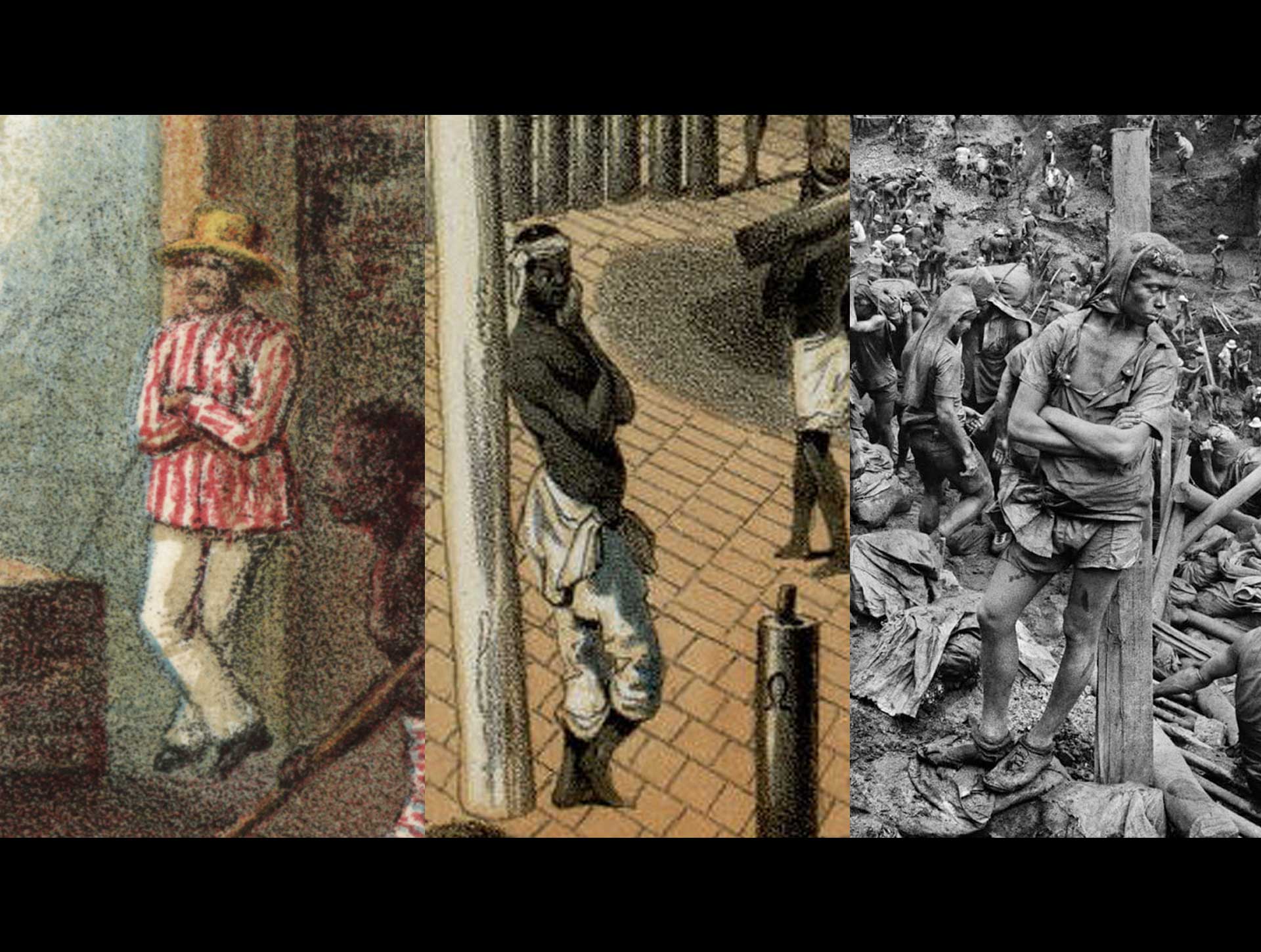
When placed next to Mialhe’s depiction of the overseer leaning against a wooden pillar, we can see that idleness does not necessarily challenge any kind of order. In the case of the overseer, the position does not even convey idleness: he is, in fact, doing his job of surveilling the work of the enslaved. It is only when idleness is performed by a person of African descent in a space associated with their labor—nineteenth-century plantation or twentieth-century gold mine—that the appearance of not working can also become an act of defiance. ■


Nineteenth-century images of plantations across the Americas usually feature slave labor to convey a sense of harmony and efficiency. Published in travel accounts and picturesque albums or commissioned by planters themselves, these images depict enslaved men and women performing manual tasks, although the extenuating aspect of their labor is often obscured. They cut and grind cane, pick and press cotton, harvest coffee, or process sugar, while light-skinned overseers and white planters seem to be standing still, at times in resting positions. In the 1835 lithograph Moulin à sucre [Sugar Mill] by Johann Moritz Rugendas, for instance, every enslaved person appears to be tending to the grinding mill on a Brazilian plantation.

Such racialization of labor is also visualized in Frédéric Mialhe’s Vista de una casa de calderas [View of a Sugar Boiling House], published in the 1855 Album pintoresco de la isla de Cuba. In this seemingly peaceful scene, the four enslaved men are the only ones engaged in physical labor: two of them tend to the boiling sugarcane juice in the caldrons, while a third one stirs the reduced juice in a resfriadera until it crystallizes. On the left, an enslaved young man—the only one wearing a shirt—serves beverages in a porcelain set to two white women. Mialhe condenses the logic of the plantation in one single space where white idleness is only possible through Black labor.

The overseers, depicted in white-and-red-striped shirts, are not engaged in physical labor: one of them is leaning against a wooden pillar while the other talks to a gentleman, presumably the plantation owner. While conventional picturesque depictions of Cuba tend to emphasize the exuberance of tropical nature, here the steam coming out of the open caldrons—a result of enslaved labor—clouds the view of the palm trees adorning the plantation.

A sense of order and efficiency is also at the center of Casa de calderas del Ingenio Asunción [Boiling House of the Asunción Plantation], by Eduardo Laplante. Like Mialhe, Laplante was a French lithographer who documented his travels around Cuba with picturesque images of slaveholding plantations while earning a living as a sales representative for sugar machinery manufacturers. This lithograph was published in the book Los ingenios: colección de vistas de los principales ingenios de azúcar de la isla de Cuba (1856-7) to accompany the text by Justo Cantero, a wealthy planter at the time.

Commissioned to showcase the alleged wealth and modernization of Cuban ingenios, the book focuses not so much on the labor of the enslaved but on technology. The description of Asunción’s boiling house emphasizes the then modern Rillieux system with horizontal evaporators (on the second floor), which contained the steam from the boiling sugar cane, making its production more efficient. The slaveholding ingenio is actually visualized here as a modernized space, reminiscent of a European factory. The enslaved workers, most of them shirtless, are all engaged in the process which, though semi-industrialized, still demanded strenuous physical labor. All except one.

At the center of the lithograph, a man stands out as the only one who seems not to be working or holding a tool. He is leaning against a wooden column with his arms and legs crossed, indicating a resting position. As is the case with most of the enslaved subjects depicted in Los ingenios, his facial features are not fully discernable. Yet, he seems to cast an ambiguous gaze—is he looking back at the viewer or out of the frame?

Significantly, this enslaved worker’s position is almost identical to that of the white overseer depicted in Mialhe’s lithograph. While the overseer is still fulfilling his duties—i.e., watching over the labor of the enslaved—the enslaved figure is clearly not working. Why would Laplante choose to depict an idle figure in this supposedly modern and efficient space? On the one hand, it could be a way of showcasing the Asunción plantation as an example of the so-called “buen tratamiento” or good treatment, an ameliorative policy envisioned by Cuban planters with the goal of extending the lives of the enslaved population in the face of trade restrictions and increases in prices. Under this logic, depicting an enslaved man at rest would convey the image that the Asunción plantation did not overwork its enslaved workforce.

Yet, large nineteenth-century Cuban plantations such as Asunción did not grant breaks to enslaved workers in a labor-intensive environment such as that of a boiling house. Nor is there the possibility of discipline here, as there is no overseer in sight: on the second floor of the boiling house, we see the sugar master, the only non-enslaved person in the image. In such a scenario, the enslaved man’s idleness poses a challenge to the plantation order, under which the bodies of the enslaved have come to index labor and subservience.

In spaces that came to signify Black labor, images of Afrodescendant workers at rest still hold the potential to challenge the visual order of racial capitalism in the Americas. In this well-known photograph taken by Sebastião Salgado in the late 1980s, a young gold miner is standing still amidst the labor of others in the Serra Pelada mine, the world’s largest open mine at the time. Salgado’s emblematic photographs documented the exploitation of more than 100,000 miners who, he lamented, “become slaves of the dream of gold and the need to stay alive.” Strikingly—yet unintentionally perhaps—Salgado’s metaphor reinforces the association between labor and Blackness. Still, this photograph briefly subverts this association by depicting, once again, an Afrodescendant worker in a moment of idleness.

In contrast to all the men around him, the young Afro-Brazilian miner in Salgado’s photograph is not engaged in labor. Like the enslaved man in Laplante’s lithograph, he is leaning against a wooden pillar. The black-and-white photograph emphasizes the chaos of the environment, where mud and men, wood and fabric, seem to merge. Unlike Laplante’s image, however, there is no ambiguity in the miner’s gaze. With his arms crossed and his head turned to the side, he seems to refuse to look at the camera. Such refusal adds another layer of challenge to the visual order of Serra Pelada captured by Salgado: not only is the young miner not mining, he is also not performing or posing for the photographer’s camera.

When placed next to Mialhe’s depiction of the overseer leaning against a wooden pillar, we can see that idleness does not necessarily challenge any kind of order. In the case of the overseer, the position does not even convey idleness: he is, in fact, doing his job of surveilling the work of the enslaved. It is only when idleness is performed by a person of African descent in a space associated with their labor—nineteenth-century plantation or twentieth-century gold mine—that the appearance of not working can also become an act of defiance. ■
Referenced works
Johann Moritz Rugendas, “Moulin à sucre,” Voyage pittoresque dans le Bré sil (Paris: Engelmann & Cie., 1835), plate 88.
Frédéric Mialhe, “Vista de una casa de calderas,” Album Pintoresco de la Isla de Cuba (Berlin: B. May y Ca., Oilprinting Storch & Kramer, 1855).

Sebastião Salgado, (Untitled) Serra Pelada, (1986-89).



